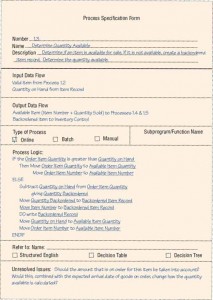Process specifications link the process to the data flow diagram, and hence the data dictionary, as illustrated in the Figure 1 below. Each process specification should be entered on a separate form or into a CASE tool screen. Enter the following information:
- The process number, which must match the process ID on the data flow diagram. This specification allows an analyst to work on or review any process, and to locate the data flow diagram containing the process easily.
- The process name, which again must be the same as the name displayed in the process symbol on the data flow diagram.
- A brief description of what the process accomplishes.
- A list of input data flows, using the names found on the data flow diagram. Data names used in the formula or logic should match those in the data dictionary to ensure consistency and good communication.
- The output data flows, also using data flow diagram and data dictionary names.
- An indication of the type of process: batch, online, or manual. All online processes require screen designs, and all manual processes should have well-defined procedures for employees performing the process tasks.
- If the process uses prewritten code, include the name of the subprogram or function containing that code.
- A description of the process logic that states policy and business rules in everyday language, not computer language pseudo-code. Business rules are the procedures, or perhaps a set of conditions or formulas, that allow a corporation to run its business. The early problem definition (as explained in Chapter “Project Management“) that you completed initially may provide a starting place for this description. Common business rule formats include the following:
- Definitions of business terms.
- Business conditions and actions.
- Data integrity constraints.
- Mathematical and functional derivations.
- Logical inferences.
- Processing sequences.
- Relationships among facts about the business.
- If there is not enough room on the form for a complete structured English description, or if there is a decision table or tree depicting the logic, include the corresponding table or tree name.
- List any unresolved issues, incomplete portions of logic, or other concerns. These issues form the basis of the questions used for follow-up interviews with users or business experts you have added to your project team.

These items should be entered to complete a process specification form, which includes a process number, process name, or both from the data flow diagram, as well as the eight other items shown in the World’s Trend example (See figure below).

Notice that completing this form thoroughly facilitates linking the process to the data flow diagram and the data dictionary.
